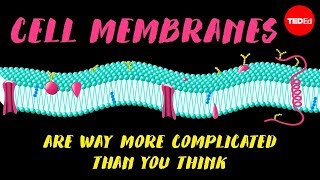(单词翻译:单击)
Cell membranes are structures of contradictions.
细胞膜是一种矛盾的组织。
These oily films are hundreds of times thinner than a strand of spider silk,
这些油性膜比蜘蛛丝还要细百倍,
yet strong enough to protect the delicate contents of life:
但是足以保护细胞膜内脆弱的生命内容物。
the cell's watery cytoplasm, genetic material, organelles, and all the molecules it needs to survive.
像水一般的细胞质,遗传物质,细胞器以及细胞生存所需要的所有分子。
How does the membrane work, and where does that strength come from?
细胞膜是怎样工作的,细胞膜的强度又是从何而来呢?
First of all, it's tempting to think of a cell membrane like the tight skin of a balloon,
首先,细胞膜容易让人联想到气球密闭的外皮,
but it's actually something much more complex.
但细胞膜其实是一种更为复杂的组织。
In reality, it's constantly in flux, shifting components back and forth to help the cell take in food,
事实上,细胞膜一直处于不断的变化之中,来回交换各种成分来帮助细胞摄入食物,
remove waste, let specific molecules in and out, communicate with other cells,
排除废物,让特殊的分子进出,和其他细胞交流,
gather information about the environment, and repair itself.
获取四周环境的信息,以及自我修复。
The cell membrane gets this resilience, flexibility, and functionality by combining a variety of floating components
细胞膜通过结合各种各样流动的成分得到这样的恢复力、适应性和功能性,
in what biologists call a fluid mosaic.
生物学家称之为流动镶嵌。
The primary component of the fluid mosaic is a simple molecule called a phospholipid.
流动镶嵌的主要成分是一种被称为磷脂的简单分子。
A phospholipid has a polar, electrically-charged head, which attracts water, and a non-polar tail, which repels it.
磷脂有一个极性的带电头部,具有亲水性,以及一个非极性的疏水尾部。
They pair up tail-to-tail in a two layer sheet just five to ten nanometers thick that extends all around the cell.
它们尾尾组合配对形成一个双层的结构,厚度仅有5到10纳米,延展至整个细胞。
The heads point in towards the cytoplasm and out towards the watery fluid external to the cell with the lipid tails sandwiched in between.
磷脂的头部朝内指向细胞质,朝外面对细胞外部的液体夹杂在中间的是磷脂尾部。
This bilayer, which at body temperature has the consistency of vegetable oil,
在体温下,这种双分子层有着像植物油一样的密度,
is studded with other types of molecules, including proteins, carbohydrates, and cholesterol.
镶嵌了许多其他种类的分子,包括蛋白质,糖类和胆固醇。
Cholesterol keeps the membrane at the right fluidity.
胆固醇帮助保持细胞膜适当的流动性。
It also helps regulate communication between cells.
它也有助于调节细胞间的交流。

Sometimes, cells talk to each other by releasing and capturing chemicals and proteins.
有时候,细胞通过释放和捕捉化学物质和蛋白质交流。
The release of proteins is easy, but the capture of them is more complicated.
释放蛋白质很简单,捕获蛋白质则更加复杂。
That happens through a process called endocytosis
这一过程被称为细胞内吞作用,
in which sections of the membrane engulf substances and transport them into the cell as vesicles.
是指部分细胞膜吞没物质并以囊泡的形式将这些物质运输至细胞内。
Once the contents have been released, the vesicles are recycled and returned to the cell membrane.
一旦囊泡内容物被释放出来,囊泡会被回收并返回细胞膜。
The most complex components of the fluid mosaic are proteins.
蛋白质是流动镶嵌中最为复杂的成分。
One of their key jobs is to make sure that the right molecules get in and out of the cell.
它们的主要工作之一是确保正确的分子进出细胞。
Non-polar molecules, like oxygen, carbon dioxide, and certain vitamins can cross the phospholipid bilayer easily.
非极性的分子,比如氧,二氧化碳和部分维生素,可以轻松穿过磷脂双分子层。
But polar and charged molecules can't make it through the fatty inner layer.
但是极性的荷电分子则无法通过脂质内层。
Transmembrane proteins stretch across the bilayer to create channels
跨膜蛋白会横跨双分子层创造通路,
that allow specific molecules through, like sodium and potassium ions.
让钠和钾离子之类的特定的分子通过。
Peripheral proteins floating in the inner face of the bilayer help anchor the membrane to the cell's interior scaffolding.
漂浮在双分子层内侧的周边蛋白质帮助将细胞膜固定到细胞内部支架。
Other proteins in cell membranes can help fuse two different bilayers.
细胞膜内的其他蛋白质可以帮助融合两个不同的双分子层。
That can work to our benefit, like when a sperm fertilizes an egg, but also harm us, as it does when a virus enters a cell.
这可以为我们带来好处,比如当精子使卵子受精,但是这也会伤害我们,比如病毒进入细胞的时候。
And some proteins move within the fluid mosaic, coming together to form complexes that carry out specific jobs.
同时,部分蛋白质会在流动镶嵌中移动,这些共同组成了可以承担特殊任务的复合体。
For instance, one complex might activate cells in our immune system, then move apart when the job is done.
例如,一个复合体也许会激活我们的免疫系统细胞,在工作完成时就会分离。
Cell membranes are also the site of an ongoing war between us and all the things that want to infect us.
细胞膜也是人类和所有入侵物持续战争的战场。
In fact, some of the most toxic substances we know of are membrane-breaching proteins made by infectious bacteria.
事实上,一些我们所知道的最具毒性的物质,是由传染性的细菌制造的能引起细胞膜破裂的蛋白质。
These pore-forming toxins poke giant holes in our cell membranes, causing a cell's contents to leak out.
这些成孔毒素会在细胞膜上穿出巨大的洞,导致细胞内容物泄漏。
Scientists are working on developing ways to defend against them,
科学家正致力研究抵御这些毒素的方法,
like using a nano-sponge that saves our cells by soaking up the membrane-damaging toxins.
比如运用纳米海绵,通过吸取破坏细胞膜的有毒物质来保护我们的细胞。
The fluid mosaic is what makes all the functions of life possible.
流动镶嵌使得生命成为可能。
Without a cell membrane, there could be no cells,
没有细胞膜,细胞就无法形成,
and without cells, there would be no bacteria, no parasites, no fungi, no animals, and no us.
而没有细胞,就不会有细菌,没有寄生虫,没有霉菌,没有动物,也不会有我们的存在。


